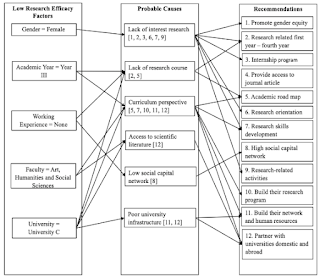RISE vol 9: Research Self-Efficacy of Cambodian Undergraduate Students at Province-Based Universities
This work is led by Cheyvuth Seng, former dean at the National University of Battambang who completed his doctoral studies at the Cross Lab.
 |
| Result Summary |
For a copy of relevant materials (e.g., presentation, paper) or any questions you may have, please feel free to reach out to me through the Contact Me gadget on this blog's side bar.
Details
Title: Research Self-Efficacy of Cambodian Undergraduate Students at Province-Based Universities
Authors: Cheyvuth Seng, May Kristine Jonson Carlon, Jeffrey S. Cross
Specifics: Volume 9, Number 2, June 25, 2020, pages 155 to 190, Hipatia Press
DOI: 10.17583/rise.2020.4267 (open access)
Abstract
Self-efficacy is crucial for producing challenging research results, which in turn may lead to innovations and development that can accelerate a country's economy. Undergraduate research self-efficacy in Cambodia has been of particular interest because graduates form the future pipeline of research professionals, which is essential for the development of Cambodia. The research self-efficacy of province-based university students, whose numbers have increased in recent years, remains uncertain and needs to be investigated. In this study, we addressed the Research Self-Efficacy Survey by Phillips and Russell (1994) and administered it to 1,009 undergraduate students from different faculties at three public province-based universities in Cambodia in order to assess their research self-efficacy. Using t-tests and ANOVA, the mean research self-efficacy score was 2.13 (± .66) on a 5 point-scale and varied significantly with a small effect size upon gender, academic year, and working experience. There is a need to focus on interventions aimed at improving the research self-efficacy of undergraduate students. This investigation also included measures and discussions such as curriculum reform, quality of teaching, teacher training, and improving educational materials and research facilities.
Comments
Post a Comment